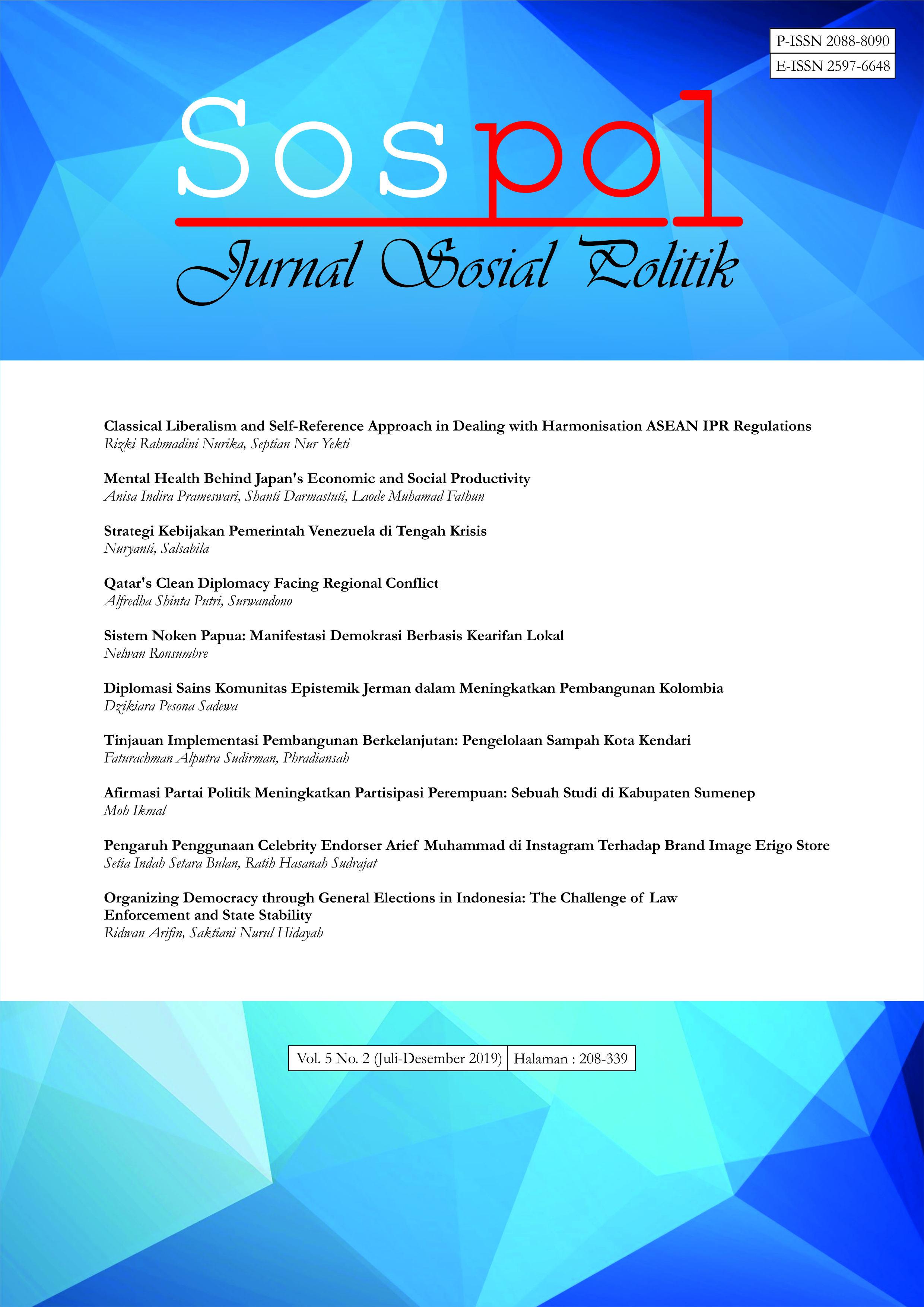Mental Health Behind Japan’s Economic and Social Productivity
DOI:
https://doi.org/10.22219/sospol.v5i2.7977Keywords:
Depression, Japan, Mental Health, SuicideAbstract
This article describes the impacts given by depression as mental health disorder and suicidal behavior towards Japan’s economy and social productivity. Depression and suicide have become one of the main causes of mortality among other health conditions in Japan. Both depression and suicidal behavior are non-communicable, yet both can influence psychological states of other people near the patient. Depression and suicidal behavior are challenging for countries with high mortality caused by suicide, especially towards those who also have ageing population like Japan. Hence, this article will analyze further costs faced by Japan along with reviewing policies taken to overcome their mental health challenges. This study uses qualitative descriptive design with case study method. This study also uses secondary analysis to answer mentioned challenges. Result shows that Japan faces economic loss to sustain their mental health expenses and psychological expenses for the family left by the victims of depression and suicide, as suicide trend is popular among adults and youths in Japan. Depression and suicidal behavior can also affect individual’s productivity. The authors expect that this can be used to give broader knowledge on non-traditional contemporary global issues.
Downloads
References
Headey, D. D., & Hodge, A. (2009). The Effect of Population Growth on Economic Growth: A Meta-Regression Analysis of the Macroeconomic Literature. Population and Development Review, 35(2), 221–248. https://doi.org/10.1111/j.1728-4457.2009.00274.x
Inoue, K., Tanii, H., Fukunaga, T., Abe, S., Nishimura, F., Kimura, Y., … Okazaki, Y. (2007). Psychosomatic tendency for suicide among the elderly in Mie Prefecture, Japan. Japanese Psychogeriatric Society, 7(2), 44–48. Retrieved from https://onlinelibrary.wiley.com/doi/epdf/10.1111/j.1479-8301.2006.00159.x
Jack, D. (2016). Chicago Unbound The Issue of Japan’ s Aging Population (No. 8). Retrieved from http://www.stat.go.jp/english/data/nenkan/pdf/yhyou02.pdf
Japan Government. (2013). White Paper on Children and Young People 2013. Retrieved from https://www8.cao.go.jp/youth/english/whitepaper/2013/pdf/part1.pdf
Japan Government. (2018). Statistical Handbook of Japan. Retrieved from http://www.stat.go.jp/english/data/handbook/pdf/2018all.pdf#page=178
Japan Government. (2019). Highlights of the Draft FY2019 Budget. Retrieved from https://www.mof.go.jp/english/budget/budget/fy2019/01.pdf
Japan Ministry of Health Labour and Welfare. (2018). Suicide Rate Japan 2014-2018. Retrieved from https://www.mhlw.go.jp/content/201812-sokuhou.pdf
Japan National Police Agency. (2017). The Situation of Suicide 2017. Retrieved from https://www.npa.go.jp/safetylife/seianki/jisatsu/H29/H29_jisatsunojoukyou_01.pdf
Japan Times. (2015). Tokyo’s Shibuya Ward Adopts Ordinance to Recognize Same-Sex Unions. Retrieved November 11, 2019, from https://www.japantimes.co.jp/news/2015/03/31/national/tokyos-shibuya-ward-adopts-ordinance-recognize-sex-unions/#.Xcj3HlczYdV
Kawanishi, Y. (2014). Mental Health Care in Japan. The Journal of Japanese Studies, 40(1), 285–289. https://doi.org/10.1353/jjs.2014.0014
Kiriakidis, S. P. (2015). Elderly Suicide: Risk Factors and Preventive Strategies. In Ann Gerontol Geriatric Res (Vol. 2). Retrieved from https://pdfs.semanticscholar.org/dbab/4a972a186a673ae2180a6a58c94bfa0e5666.pdf?_ga=2.256408267.1959911486.1567137091-312667429.1563869213
Leibenstein, H. (1954). A Theory of Economic-Demographic Development. The Journal of Economic History, 15(2), 190–191. https://doi.org/10.1017/s0022050700058289
Leng, T. L. (2014). Generations in Touch: Linking the Old and Young in a Tokyo Neighborhood. New York: Cornel University Press.
Lies, E. (2019). Helping, Listening, Caring: Japanese Prefecture Leads Dramatic Decrease in Suicides. Retrieved October 18, 2019, from https://www.reuters.com/article/us-japan-suicides/helping-listening-caring-japanese-prefecture-leads-dramatic-decrease-in-suicides-idUSKCN1RJ0QL
Oblander, E., Park, S. C., & Lemaire, J. (2016). The Cost of High Suicide Rates in Japan and the Republic of Korea: Reduced Life Expectancies. Asia-Pacific Population Journal, 31(2), 21–44. Retrieved from https://www.unescap.org/sites/default/files/publications/APPJ Vo.31No.2.pdf
OECD. (2017). Life Expectancy at Birth. Retrieved from https://www.oecd.org/els/family/CO_1_2_Life_expectancy_at_birth.pdf
Okumura, Y., & Higuchi, T. (2016). Cost of Depression Among Adults in Japan. 13(3), 1–13. https://doi.org/10.4088/PCC.10m01082
Payne, S., Swami, V., & Stanistreet, D. L. (2008). The social construction of gender and its influence on suicide: a review of the literature. Journal of Men’s Health, 5(1), 23–35. https://doi.org/10.1016/j.jomh.2007.11.002
Rumjahn, Fonseca, Prameswari, Satou, Hiep, Kasai, & Hironaka. (2018). Embracing Diversity in Japan’s Education System. ISC 64 Journal.
Snyder, R. (2010). The Androgyne Patriarchy in Japan Contemporary Issues in Japanese Gender. Retrieved from https://pdfs.semanticscholar.org/94f0/79c14a592173a0f721bcc784271ce9b8e82d.pdf
Sprenkle, D. H., & Bischof, G. P. (1994). Contemporary family therapy in the United States. Journal of Family Therapy, 16(1), 5–23. https://doi.org/10.1111/j.1467-6427.1994.00773.x
Takahashi, Tsukue, Kawasaki, Watanabe, & Seki. (2013). Depression and Suicide Countermeasures in Japan. Depression and Suicide Countermeasures in Japan, 56, 14. Retrieved from https://www.med.or.jp/english/journal/pdf/2013_03/129_142.pdf
Vos, T., Flaxman, A. D., Naghavi, M., Lozano, R., Michaud, C., Ezzati, M., … Murray, C. J. L. (2012). Years lived with disability (YLDs) for 1160 sequelae of 289 diseases and injuries 1990-2010: A systematic analysis for the Global Burden of Disease Study 2010. The Lancet, 380(9859), 2163–2196. https://doi.org/10.1016/S0140-6736(12)61729-2
WHO. (2018a). Life Expectancy and Healthy Life Expectancy. Retrieved October 18, 2019, from http://apps.who.int/gho/data/view.main.SDG2016LEXv?lang=en
WHO. (2018b). Suicide Data. In World Health Organization. Retrieved from https://www.who.int/mental_health/prevention/suicide/countrydata/en/
Downloads
Published
How to Cite
Issue
Section
License
Authors who publish with this journal agree to the following terms:
- Authors retain copyright and grant the journal right of first publication with the work simultaneously licensed under a Creative Commons Attribution-ShareAlike 4.0 International License that allows others to share the work with an acknowledgement of the work's authorship and initial publication in this journal.
- Authors are able to enter into separate, additional contractual arrangements for the non-exclusive distribution of the journal's published version of the work (e.g., post it to an institutional repository or publish it in a book), with an acknowledgement of its initial publication in this journal.
- Authors are permitted and encouraged to post their work online (e.g., in institutional repositories or on their website) prior to and during the submission process, as it can lead to productive exchanges, as well as earlier and greater citation of published work (See The Effect of Open Access).

This work is licensed under a Creative Commons Attribution-ShareAlike 4.0 International License.



















